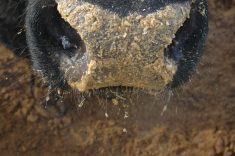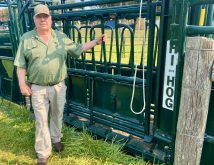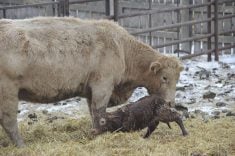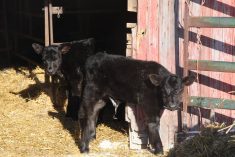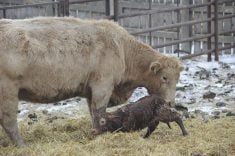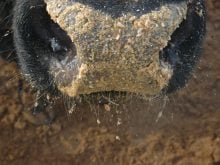A penile hematoma, also known as broken penis, is an injury that most often occurs in bulls that breed cows in pasture
Bulls occasionally get injured when fighting or breeding.
Jennifer Pearson, assistant professor of production animal health at the University of Calgary, said most injuries happen during breeding season.
“These injuries fall into two categories: reproductive injuries and musculoskeletal injuries, usually feet and legs.
“A common reproductive injury is a penile hematoma, often called broken penis. If the connective tissue surrounding the penis is bent too much, it breaks, tears and leakage of blood creates a lot of swelling,” she said.
These injuries are common in bulls that breed cows in pasture, as opposed to a confined situation or when semen is collected for artificial insemination.
Read Also

Canada’s slaughter horse industry lacks transparency
The lack of clear reporting and public access to data keeps the industry largely hidden, leaving questions about humane treatment and traceability unanswered.
“Bulls can also develop penile or preputial laceration. They injure the tissue that covers the penis either due to a breeding injury or when travelling through shrubs.”
A bull might follow a cow without completely retracting the penis so its covering gets snagged. Injuries discourage bulls from breeding.
“There are several treatment options and the bull may heal and recover, depending on how severe the injury is,” said Pearson.
“These can be treated surgically or medically. For medical treatment, we usually put them on antibiotics and pain medication. Cold water therapy is helpful, such as cold hosing, to try to decrease inflammation and swelling.
“Inflammation is important for healing, but too much inflammation can lead to scar tissue and adhesions that make it impossible for the bull to extend the penis and breed cows.”
The other category of injuries includes broken legs, torn ligaments in the stifle joint and various lameness issues. They are hard to predict and prevent.
Bones can snap if one bull rams another while the hind legs are braced.
“I’ve seen this type of injury the past few breeding seasons. I didn’t see it happen but what we think happens is the bull was mounting a cow with all his weight on his hind legs and another bull rammed him from the side,” she said.
There is little research on fighting and breeding injuries.
“I have a PhD student starting a project in January, hoping to look at social interaction and hierarchy in bull groups, and how that impacts siring capacity. We want to determine if there are certain behaviour characteristics that could guide us in whether certain bulls could be pastured together or kept together in breeding groups because they already have their pecking order figured out. Those bulls might spend less time fighting and more time doing their job and breeding cows.”
Community pastures bring bulls together from different sources so they spend a lot of time fighting to establish social hierarchy.
“There are no good ways to prevent that, unless you can introduce bulls before they have to breed cows. If you can have preselected breeding groups, so they’ve already settled their dominance order, this might help,” said Pearson.
Greater space may also reduce fighting because younger or less aggressive bulls can stay away from more dominant bulls. Even so, fights will occur.
“We see this quite a bit, with any mixing of groups. I conducted a research project the past two years, looking at bull behaviours in small groups. When I tried to reintroduce them out again into the rest of the bull herd, they fought again.”
Younger bulls are often timid enough to avoid older bulls, but if two older, dominant bulls are together, they may fight until one gets thoroughly beaten. If evenly matched, they may fight all summer.
“It’s interesting to observe how these hierarchies change. In my research with bull groups, the first year I had two dominant bulls in different groups, and they bred the majority of the cows.
“The producer decided to put them together the next year, in the same breeding group, and they spent the whole season fighting. They were both accustomed to being the dominant bull and spent all their time fighting instead of breeding,” Pearson said.
Producers should ensure bulls are not intimidated to the point that they don’t breed cows. Those bulls might be better in a pasture by themselves with a few cows, or paired with a less dominant bull.
Horns are a major factor in dominance. Horned bulls have an advantage and may also cause injuries.
“One solution is to use polled genetics or dehorn those bulls when they are calves,” said Pearson.
Another option is to remove part of the horn when bulls are yearlings.
Some injuries from horned bulls can kill a rival or damage eyes and other body parts. A horned bull can also bleed to death if a horn breaks off near its base.
“Even if they don’t bleed enough to die, you have to worry about that open sinus when a horn breaks off. Flies can get in there, and the bull may develop a sinus infection,” Pearson said.
Close herd monitoring can quickly identify injuries and allow for speedy treatment.
To minimize injuries, producers should evaluate bull conformation when selecting sires.
“Generally, people just check for lameness and if the bull is not lame they figure he is good to go. But we need to score feet and leg conformation and angles. Are the hind legs too straight in the hocks and stifles?”
Post-legged bulls have more joint strain when breeding and don’t travel as well as bulls with normal leg angles.





